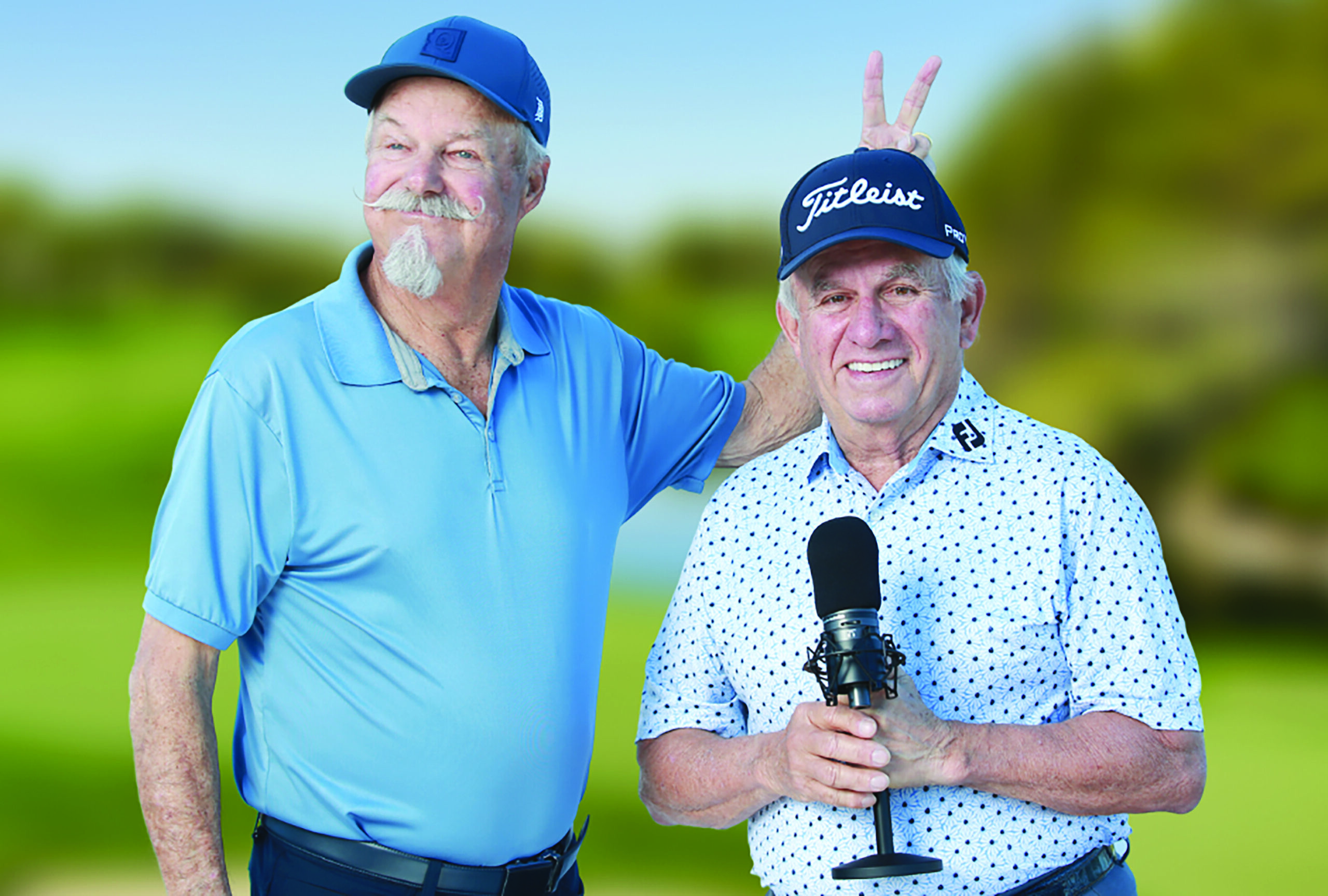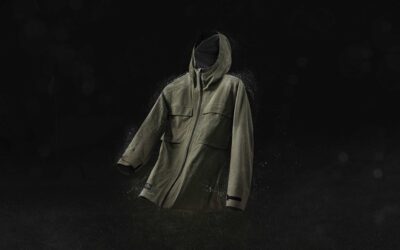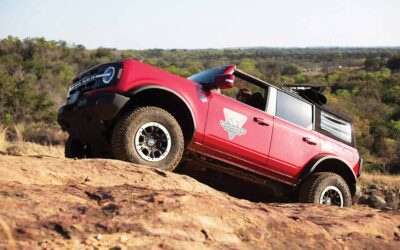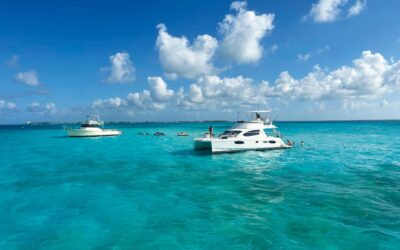Gary McCord, Of His Own Accord
A Journey into the Mind of One of Golf’s Great Free Spirits
By Carl Mickelson
Gary McCord’s mind never stops churning. Picture the Energizer Bunny on six shots of espresso. That’s what it’s like as the former PGA Tour player and longtime golf broadcasting legend goes through his day, part court jester, constant tinkerer, and consummate raconteur.
The thing is, his body has to keep pace, too. So, he plays golf more days than he doesn’t, he hikes just as much, he performs magic tricks, and he’s always in some level of conversation with somebody at his beloved Whisper Rock Golf Club in Scottsdale. Lately, he’s found a couple of new hobbies to keep him occupied and to put that gargantuan brain-energy to good use. He’s podcasting and metal detecting and seriously considering combining the two.
The Southern California native was a two-time Division II All-American for the UC Riverside Highlanders of the University of California, Riverside. He won the NCAA Division II individual championship in 1970 and turned professional in 1971. McCord played in over 400 PGA Tour events but never won. Underrated as a player, because of his nearly four decades of broadcasting prowess, let’s not forget he won twice on the PGA Tour Champions and is a tough draw in matches with his fellow Whisper Rock members, which include more than three dozen touring professionals.
McCord is co-hosting an irreverent but sharply produced video podcast with his longtime broadcast partner and golf teaching legend Peter Kostis. Kostis and McCord: Off Their Rockers is only about a half dozen episodes into its run, but the level of storytelling and dishy behind-the-scenes goodness found on the show has already caused the program to go viral on golf sites and social media multiple times.
After all these years, people are still fascinated by the backstory of why McCord was banned from broadcasting at The Masters. Everyone knows the now-verboten line included “bikini wax,” but McCord, who turns 75 in May, is recently freed up to tell more of the origins of how that line turned into one of golf’s most memorable controversies. And, the real story is a must-hear tale involving Green Coats, TV execs and a mercurial World Golf Hall of Famer.
Now, Kostis and McCord are completely unleashed and able to use the podcasting medium to say everything they couldn’t say on CBS broadcasts. The result is a delightfully easy and fun listen and a trip into the minds of two of golf’s brightest bulbs.
We sat down recently with McCord to catch up on his life and his uncommonly droll perspective on what’s happening in the game today. Enjoy the conversation here.
What has it been like for you and Peter Kostis to do a podcast with absolutely no restraints on what you can say?
It’s probably a lot like taking your clothes off in public. Like, okay, now I can do all the stuff we wanted to do but under the guise of CBS, you couldn’t do it. Toward the end of our careers, as things get tighter, I saw myself editing my own words before I said them, and I had never done that before my career. It just got worse and worse. It became kind of a collision between the network and the ability to paint a picture as we had done in the past, which I couldn’t do now in the future because I just winged it at first and we just, I didn’t care what came out or anything else. That being said, I did it for 34 years, or something like that. It was a ball.
I really like doing this podcast now because I can do any fricking thing I want along with Peter and our producer, Mike Abram.
So many golfers feel like they know you guys from TV, so to be able to go behind the curtain with you and laugh at all the behind-the-scenes stories and hijinks is a real treasure for golf nuts.
Yeah, you know, you’ve got your easel there and you can paint anything you want on it, doing any any way, shape, form, or any medium you want. So, to me that’s tantalizing. Because I want to do things totally differently.
Differently, how?
I’ve got a very nice club here in Scottsdale and we’re there’s a lot of really good players, 37 different tour pros here. So, the other day I just walked out with my metal detector and started metal detecting all up and down the range. Seeing if I could find any gold watches, rings, anything else in the ground and I also go up in the mountains here, around the golf course.
What’s the coolest thing you’ve found so far?
So, they used to shoot movies here, back in the 1940s and ‘50s, cowboy movies. So, I found a couple of those sites. I found some old cartridges in the ‘50s that were that were blanks. We looked them up and found the era they’re from. So, I’m looking for gold out here in all the reservoirs and stuff. It’s kind of funny. So, that’s basically how I’m going do my interviews with guys that play golf.
I’ve got another metal detector and we’re going take golfers metal detecting. You know, try not to get bit by rattlesnakes, and we’ll talk as we metal detect.
I love that! The late, genius comedian Norm MacDonald used to wonder why, with every single talk show, the set was always a desk, a chair and a couple of other chairs. Same set. Every time. Then another comedian, Kevin Nealon started doing his podcasts where they hike, and they talk as they walk the canyons.
I’m pretty sure none of these guys at this club have ever done it, either. Given their socioeconomic status, I don’t think one of them has ever put headsets on and metal detected. These new metal detectors will ring differently when they hit metal, gold, silver, zinc, all those things. I will be quite an education for them.
You touched on something interesting, your unique perspective on things… you’re a little bit North by Northwest, if you will and that has been magnificent for your career and has taken you to amazing places. You started, though, in the same place the legendary comedian Steve Martin did. You guys went to the same high school, and you knew each other. You’re both funny. You both do magic acts. How intertwined is the Steve Martin thing with you?
Nothing other than the fact that we went to high school at the same time. He was the head cheerleader at Garden Grove High School and head of the drama class. We’re talking about 1963. Everybody was fairly naive back in the early 60s. It was the era of picket fences, Mom having the nice dress on when dad came home from work. Pure Ozzie and Harriet. Then I saw crazy, and I didn’t know what crazy was, but this guy was different. This guy was really different. I kept watching him, but I was on the freshman basketball team. I kept watching him, then he was at Disneyland.
He did the magic shows, right?
He worked in the magic shop on the weekends. There’s a bridge that goes over to Fantasyland and there’s a magic shop right around the corner there in the back. He would get his tray out in the middle of that bridge and do the balloon animals on his head with the arrow through his head and start going to town. I would just sit there, and watch and I became very infatuated with it. And that was it. He doesn’t remember me, but he was brilliant.
So, you were inspired by him?
I probably was, yes. He was the first guy that I saw that was a deviant, and I liked it.
Let’s dive back into your broadcasting career. I learned it was at The Memorial tournament back in the 80s where you got your start, and if not for a wayward putt by Bob Eastwood, your career might have gone a different way.
Yeah, that was how I got the job. CBS totally happened by chance. I was at Colonial and was flying Monday to Muirfield Village for Jack Nicklaus’ tournament, The Memorial, which was a designated event I was not qualified to play in. I was, though, one of the three player directors chosen by the PGA Tour, which, in itself, is a frightening concept.
So, I was in an airplane going into the tournament. All the CBS boys – Pat Sumrall, Ken Venturi, Ben Wright and Frank Chirkinian – were in first class, and I’m in 37 C, way in the back. Halfway through the flight, they send me back a glass of wine. So, I go to thank them and while I’m walking up towards the first class, I’m thinking Wednesday is the last time I’m on the PGA Tour’s bill because our policy board meetings are over, then I’ve got to travel to Washington DC, which is very expensive. And I was under a very tight budget from shooting 76 every day.
So, I said, ‘Let me ask you a question. I’m on the policy board members, I’m making decisions as to contracts for CBS, ABC, ESPN, in other networks and I know nothing about televised golf. Is there a chance I could come and sit and watch you this weekend and see how it works? It might help me better prepare for the next vote.’ Chirkinian tells me to come out Friday I just assume I’ll be a fly on the wall, watching the production happen. Well, I get there and sends me straight out to the 16th hole where I assume I’ll be a spotter, getting the club Freddie Couples is hitting from Joe LaCava and relaying it to the tower. I get there and Verne Lundquist calls me up to join me in the tower to call the action with him.
Frank wanted to try me out as an announcer. I had a lot of fun. I had no clue what was going on. I don’t know who was talking to me. It’s really confusing when you’re saying something and there’s other voices. Now, I’ve got enough voices anyway in my head and now I’ve got all these voices going nuts. And to try to figure that out in one weekend was fantastic. Toward the end of the round, Verne and I are watching the green at 16 which slopes severely from back to front and player has gone over and has to pitch back to this lightning fast green. Verne goes, ‘Gary what’s he got?’ I said ‘Well, all you people out there, here’s what he’s got. I want you to go get a ball and a wedge and go out to your front lawn. Chip on to your driveway and start hollering for it to bite. That’s what he’s got.’ Verne started laughing and after the tournament was over, Frank calls me back to the trucks and sits me down to ask what I’m doing next week. I go, ‘I’m playing Kemper in Washington D.C.’ He says, ‘Great. You’ll miss the cut. Come on up in the tower again.’ Really nice. Thank you. So, I did that for three years. They paid me $500 a weekend for three years. I played golf and, if I missed the cut, I went up and did television and then, finally, I went full time in 1990.
Something else about you is your eye for talent. You singled out David Feherty as a great fit for CBS and I’ve heard you were also influential in encouraging Colt Knost to get into broadcasting. One of the things I didn’t realize, or remember, until recently was the depth of your involvement in the movie Tin Cup. You were an actor in the film, you were a technical consultant, you recruited talent and you were deeply involved in the production, not only getting Kevin Costner to actually look like a golfer and getting some of the PGA Tour talent out there. You were integral to telling the story and some of the lead character’s stories were based on your exploits.
I was hired as the technical director at a time when I was already plenty busy with broadcasting and doing a bunch of corporate outings. I got this script from Warner Brothers from my agents, working title is Tin Cup, starring Kevin Costner, written and directed by Ron Shelton. What? So, the first time you ever get a movie script, and they say you’re in it, you go really fast and see how many times you see your name. But, then I read the damn thing afterwards, and a lot of the stories in there, I did. Me.
Right, multiple things the character Roy McAvoy did were pulled from of your life and career, like knocking the pelican off of his roost and the blow up where you go thermonuclear in a tournament and card a 15 on a hole…
Right, I went nuclear on the 16th hole at Memphis, so I read that, and I call Ron Shelton, who I didn’t know, but I knew who he was, and the first question was ‘Ron, where the hell did you get these stories?’ He goes ‘Which ones?’ I said, ‘Okay, what about the end when he hits the ball in the water?’ He says, ‘I read you did that.’ No one knows I did that. No one’s following me. No one’s following my career.
He read that in a magazine, he says, but the pelican story, there was no chance anyone knew this story. There were only four guys who were staying in this condo that we’d rented. Were in a rainout.
We’re playing gin as it’s pouring down rain. I look out the window, we’re in Pensacola, Florida, right on a canal and there’s a wharf out there that we’re a right by the house we rented. Well, a pelican landed about 150 yards away, and we’re gambling anyway and I’m in the back of the house and my clubs right there. I say, ‘Hey, boys. I got a bet for you. If we open the doors and move some furniture, I bet I can knock this pelican off his perch in 10 shots. I don’t know how much money we had up, but it was enough to pay attention. We’re talking a four-iron out of the back bedroom, down the hallway, over the couch, through the sliding glass doors over the wooden railing right at the pelican. It went about a foot over his head and the pelican took off! Literally, the best shot I’ve hit in my life and it had to happen at a condo in Pensacola. Only four guys witnessed this.
Could you ever have imagined that making it into the plot of a motion picture?
No. It’s still frightening to me that Ron then goes and shoots the scene. It took three days in a bar that they built specially for the scene, and they used three trained pelicans to try to pull this off. I didn’t know they had trained pelicans. To watch all the effort that was made and and the dollar amount to build these things to bring this stupid scene to life was unbelievable.
So, are we seeing camera tricks or could Kevin Costner actually pull off a shot similar to the one you hit in Pensacola?
Let me answer it this way. Kevin was having a tough time getting a wiffle ball out the door because you’re talking about a room full of people sitting everywhere and getting the ball out the two doors.
I suggested to Ron that we can do a two shot and combine with the master shot. I said can we just cut to Kevin taking a swing and hit it, but then I’ll give it a whack and I get it through the door without killing anyone and make the pelican fly. That’s easy enough. Then, we can go back to Kevin and shoot his follow through. Well, the deal is that movie stars like to do it themselves. They will act according to how they hit the shot.
I’m starting to see how this took three days.
He didn’t play golf before this shoot. He told me he has played like 12 times with his father. That’s it. So he wasn’t used to hitting golf shots or doing anything with a golf club. And, honest to God, if you look at him on the film and how good he was, and he’s only played 12 times? We played nine holes once and he shot even par. It’s unbelievable what an athlete he was. And I learned quickly that they only act after they do the motion correctly, so that master shot was him getting the ball through those doors.
Unbelievable. Let’s switch gears The Masters, the dominance of Jon Rahm, Scottie Scheffler and Rory McIlroy. What’s your feeling on the state of the game today and its stars?
Well, I think honestly the star of the show at The Masters was LIV, if you look at how their players performed. For the first time in our existence, we’ve got a rival tour. The monopoly is gone, and we’ve got something to gauge it against. Look what’s happened to the DP World Tour and to the PGA Tour. The prize money has rocketed skyward in a year. A lot of that was due to the $736 million per year the PGA Tour is getting through 2030 right media rights.
All of a sudden, the tour has taken on a whole different look. It has gone from the all-exempt tour, with 125 guys now it’s shrunk back to the old days to where 50 to 65 guys have the best playing opportunities. So, there’s shrinkage situation. There’s also shrinkage as far as the title sponsors who have tournaments.
Are there specific PGA Tour events you worry about in a sponsorship scenario where there seems to be Haves and Have-Nots?
That’s going to be interesting because that’s all due to competition and how bad they want to stay there. But, when you start dividing this tour into the haves and the have nots from the player standpoint, and from the title sponsors, you can imagine that if one tournament, we’ll take Honda this year, for example. Honda pulled out the event and has a designated $20 million tournament in front of it and after it. All of a sudden, you’ve got no field and no money, so how long can you support that? We found Honda wasn’t going to support it for very long, they got out, and they were one of the tour’s longest sponsors. That’s a pretty good indicator of the cost effectiveness of what’s going on, and who’s going to dominate this. The tour is getting smaller with the number of players who are exempt and maybe the tour is going to get smaller as we look at the title sponsors.
Have you had an offer from LIV Golf to join David Feherty and do their broadcasts?
I talked to Greg Norman two or three times. The last time he was going to call me was December of last year, and they still had no television network.
He never called back, but my position was I’m too old to get in an airplane to go to Riyadh, to go to Adelaide, to go to Bangkok, to go all over the freakin’ place. Now, if you did a studio in the United States and David and I got in there with the host, that would work. Golf is going to be done like that in the future. I can’t believe they’re still putting people on site. If you put us in a studio, let’s Scottsdale or Dallas, or wherever, you can never tell we’re not at the tournament. All I need is somebody on the ground that tell me what the lie looks like and where the wind is blowing, and just get somebody else to do the interviews. Everything else can be done in a studio and you save all the travel and logistical costs.
I didn’t tell that to Greg, but that was my feeling if he was going to call. I’m not getting an airplane like David. I talked to David three days ago. You know, ‘How are you doing? Where are you going next?’ Adelaide, Bangkok… Whoa, man. I don’t want to do that. That would be the reason if they ever called back and made an offer.
Fair enough. We’re not going to have you on the CW for LIV broadcasts, but we look forward to more content where people can find you and your good friend Peter Kostis, on Kostis & McCord: Off Their Rockers on YouTube and anywhere podcasts are available.
Thank you. I’ll see you later. You take care.
By Carl Mickelson





